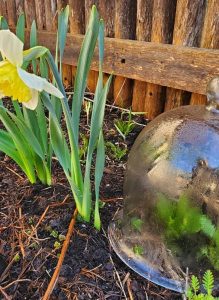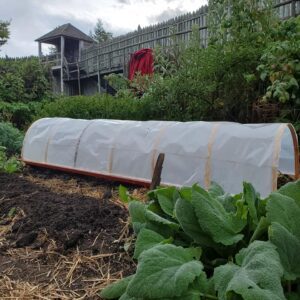As many visitors to Colonial Michilimackinac know, we have a lot of gardens inside the palisade. The walls of the fort, as well as the geography of northern Michigan, create a unique climate at our site. But what if we need more protection from the weather? In the 18th century, gardeners devised a number of creative ways to extend the growing season and control the climate to shelter their garden plants.
Starting in the 17th century, some gardeners began using a tool called a bell jar, or cloche. Resembling a small bell, glass cloches functioned as a miniature greenhouse. Gardeners placed jars over an individual plant, occasionally with one side propped up to allow air circulation. Sunlight passing through the glass warmed the air inside. While it may be cool outside, the plant underneath the glass stayed cozy and warm, and continued growing where otherwise it may not have survived. This method is useful at Michilimackinac today when we are setting out our warm-weather crops, such as melon and cucumber, which need warm temperatures to grow well.
Another tricky tool that gardeners used was a row cover. Row covers were inexpensively built with paper, glue, a wooden frame, and linseed oil. Although seemingly fragile and susceptible to damage, even from a heavy rain, paper row covers were surprisingly resilient. Gardeners could expect to get a full summer’s use before the paper would need to be replaced. If we can keep the chickens away from them, our row covers at Michilimackinac usually last from April to October.
The most labor-intensive way of protecting plants in a small garden involved the use of cold frames and hot beds. These wooden boxes needed to be built with “lights” or windows on the top, and were usually oriented toward the southern sky to catch as much light as possible. They worked by trapping heat from the sun under the glass, similar to a cloche but on a larger scale. Gardeners could further heat the interior of their frames by placing them over a pit filled with fresh manure. With a layer of soil on top of the manure, these hot beds could reach temperatures high enough to start planting lettuce outside in a Michigan March.
Various gardening how-to books from the 18th century suggest the use of an assortment of strategies and tools to protect important plants from the cold and the wind. Stop by Colonial Michilimackinac to see if you can spot the cloches, row covers and frames that are keeping our plants happy. Many elements of our gardens, including the cloches, were provided through the generosity of Mackinac Associates. If you would like to contribute to the Michilimackinac gardens, or any other Mackinac State Historic Parks’ project, consider becoming a Mackinac Associate today.












